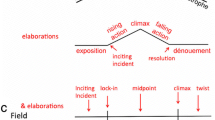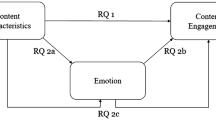Abstract
While various theorists explain the postmodern moment or culture by pointing at an acceleration of transformations in macro-social institutions, such explanations remain often abstract and removed from everyday experience. Seeking to concretize how speed is articulated in popular texts, I analyze here the various strategies TV commercial ads deploy to inscribe speed as a normal and desirable quality of everyday life, objects, and self. Focusing on both pictorial and textual dimensions, I call the reader's attention to these strategies, and discuss the possible social and psychological consequences of the ideological orientations they articulate.
Similar content being viewed by others
REFERENCES
Ansay, P. (1994). Le capitalisme dans la vie quotidienne [Capitalism in Everyday Life-untranslated]. Bruxelles: Éditions Vie Ouvrière.
Baudrillard, J. (1988). America. London: Verso.
—. (1970). La société de consommation: Ses mythes, ses structures. Paris: Gallimard.
Benjamin, W. (1976). Illuminations. New York: Schocken Books.
Bertman, P. (1998). Hyperculture: The human cost of speed. Westport: Praeger.
Debord, G. (1983). The society of the spectacle. Detroit: Black and Red.
DeLillo, D. (1986). White noise. New York: Penguin.
Ferrarotti, F. (1990). Time, memory, and society. New York: Greenwood Press.
Finkielkraut, A. (1980). Le Juif imaginaire. [The Imaginary Jew—untranslated] Paris: Éditions du Seuil.
Gergen, K. (1991). The Saturated self. New York: Basic Books.
Goldman, R. and D. R. Dickens. (1983). “The selling of rural America.” Rural Sociology 48(4), 585–606.
Gottschalk, S. (1997). “The pains of everyday life: Between the D.S.M. and the postmodern.” Studies in Symbolic Interaction Vol. 21, 115–146.
—. (1993). “Uncomfortably numb: Countercultural impulses in the postmodern era.” Symbolic Interaction Vol. 16(4), 351–378.
Harvey, D. (1989) The Condition of postmodernity. Cambridge: Basil Blackwell.
Langman, L. 1992. Neon cages: Shopping for subjectivity. In R. Shields (ed.), Lifestyle shopping: The subject of consumption (pp. 40–82 London: Routledge.
Pfohl, S. (1992). Death at the parasite cafe: Social science (fictions) & the postmodern. New York: St. Martin.
Postman, N. (1985). Amusing ourselves to death. New York: Viking.
Rifkin, J. (1987). Time wars: The primary conflict in human history. New York: Henry and Holt.
Rosenau, P. M. (1992). Post-modernism and the social sciences: Insights, inroads, and intrusions. Princeton: Princeton University Press.
Schor, J. B. (1993). The overworked American: The unexpected decline of leisure. New York: Basic Books.
Virilio, P. (1996). Cybermonde: La politique du pire. [Cyberworld: The politics of the worst, untranslated]. Paris: Textuel.
—. (1995). “Speed and information: Cyberspace alarm.” CTheory World Wide Web Vol. 18(3) Article 30.
—. (1990). Popular defenses and ecological struggles. New York: Semiotext(e).
— (1986). Speed and politics. New York: Semiotext(e).
Wernick, A. (1991). Promotional Culture: Advertising, ideology and symbolic expression. London: Sage.
Williamson, J. (1992). Decoding advertisements: Ideology and meaning in advertising. London: Marion Boyars.
Author information
Authors and Affiliations
Rights and permissions
About this article
Cite this article
Gottschalk, S. Speed Culture: Fast Strategies in Televised Commercial Ads. Qualitative Sociology 22, 311–329 (1999). https://doi.org/10.1023/A:1022007721264
Issue Date:
DOI: https://doi.org/10.1023/A:1022007721264




